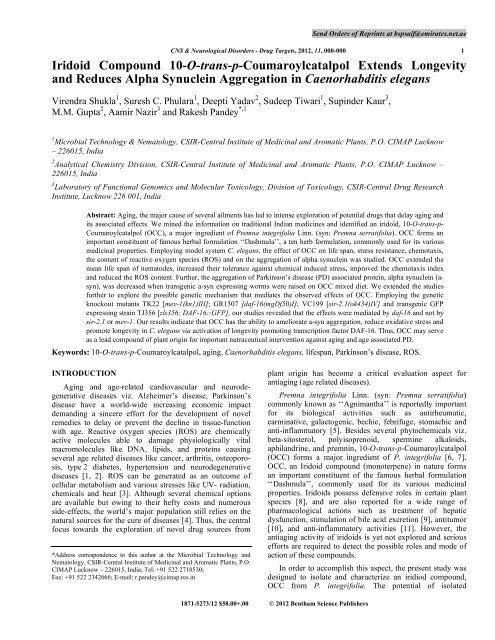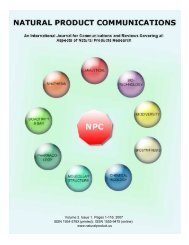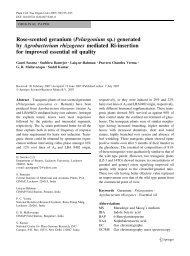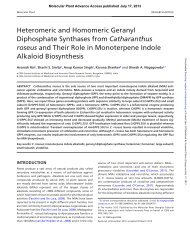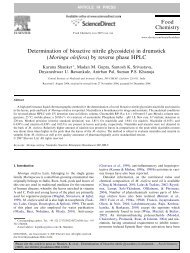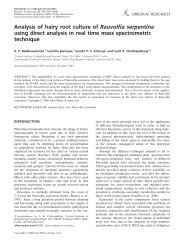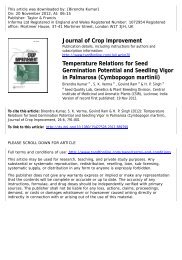Virendra Shukla, Suresh C. Phulara, Deepti Yadav ... - CIMAP Staff
Virendra Shukla, Suresh C. Phulara, Deepti Yadav ... - CIMAP Staff
Virendra Shukla, Suresh C. Phulara, Deepti Yadav ... - CIMAP Staff
You also want an ePaper? Increase the reach of your titles
YUMPU automatically turns print PDFs into web optimized ePapers that Google loves.
Send Orders of Reprints at bspsaif@emirates.net.aeCNS & Neurological Disorders - Drug Targets, 2012, 11, 000-000 1Iridoid Compound 10-O-trans-p-Coumaroylcatalpol Extends Longevityand Reduces Alpha Synuclein Aggregation in Caenorhabditis elegans<strong>Virendra</strong> <strong>Shukla</strong> 1 , <strong>Suresh</strong> C. <strong>Phulara</strong> 1 , <strong>Deepti</strong> <strong>Yadav</strong> 2 , Sudeep Tiwari 1 , Supinder Kaur 3 ,M.M. Gupta 2 , Aamir Nazir 3 and Rakesh Pandey *,11 Microbial Technology & Nematology, CSIR-Central Institute of Medicinal and Aromatic Plants, P.O. <strong>CIMAP</strong> Lucknow– 226015, India2 Analytical Chemistry Division, CSIR-Central Institute of Medicinal and Aromatic Plants, P.O. <strong>CIMAP</strong> Lucknow –226015, India3 Laboratory of Functional Genomics and Molecular Toxicology, Division of Toxicology, CSIR-Central Drug ResearchInstitute, Lucknow 226 001, IndiaAbstract: Aging, the major cause of several ailments has led to intense exploration of potential drugs that delay aging andits associated effects. We mined the information on traditional Indian medicines and identified an iridoid, 10-O-trans-p-Coumaroylcatalpol (OCC), a major ingredient of Premna integrifolia Linn. (syn: Premna serratifolia). OCC forms animportant constituent of famous herbal formulation ‘‘Dashmula’’, a ten herb formulation, commonly used for its variousmedicinal properties. Employing model system C. elegans, the effect of OCC on life span, stress resistance, chemotaxis,the content of reactive oxygen species (ROS) and on the aggregation of alpha synuclein was studied. OCC extended themean life span of nematodes, increased their tolerance against chemical induced stress, improved the chemotaxis indexand reduced the ROS content. Further, the aggregation of Parkinson’s disease (PD) associated protein, alpha synuclein (asyn),was decreased when transgenic a-syn expressing worms were raised on OCC mixed diet. We extended the studiesfurther to explore the possible genetic mechanism that mediates the observed effects of OCC. Employing the geneticknockout mutants TK22 [mev-1(kn1)III]; GR1307 [daf-16(mgDf50)I]; VC199 [sir-2.1(ok434)IV] and transgenic GFPexpressing strain TJ356 [zls356; DAF-16::GFP], our studies revealed that the effects were mediated by daf-16 and not bysir-2.1 or mev-1. Our results indicate that OCC has the ability to ameliorate a-syn aggregation, reduce oxidative stress andpromote longevity in C. elegans via activation of longevity promoting transcription factor DAF-16. Thus, OCC may serveas a lead compound of plant origin for important nutraceutical intervention against aging and age associated PD.Keywords: 10-O-trans-p-Coumaroylcatalpol, aging, Caenorhabditis elegans, lifespan, Parkinson’s disease, ROS.INTRODUCTIONAging and age-related cardiovascular and neurodegenerativediseases viz. Alzheimer’s disease, Parkinson’sdisease have a world-wide increasing economic impactdemanding a sincere effort for the development of novelremedies to delay or prevent the decline in tissue-functionwith age. Reactive oxygen species (ROS) are chemicallyactive molecules able to damage physiologically vitalmacromolecules like DNA, lipids, and proteins causingseveral age related diseases like cancer, arthritis, osteoporosis,type 2 diabetes, hypertension and neurodegenerativediseases [1, 2]. ROS can be generated as an outcome ofcellular metabolism and various stresses like UV- radiation,chemicals and heat [3]. Although several chemical optionsare available but owing to their hefty costs and numerousside-effects, the world’s major population still relies on thenatural sources for the cure of diseases [4]. Thus, the centralfocus towards the exploration of novel drug sources from*Address correspondence to this author at the Microbial Technology andNematology, CSIR-Central Institute of Medicinal and Aromatic Plants, P.O.<strong>CIMAP</strong> Lucknow – 226015, India; Tel: +91 522 2718530;Fax: +91 522 2342666; E-mail: r.pandey@cimap.res.inplant origin has become a critical evaluation aspect forantiaging (age related diseases).Premna integrifolia Linn. (syn: Premna serratifolia)commonly known as ‘‘Agnimantha’’ is reportedly importantfor its biological activities such as antirheumatic,carminative, galactogenic, bechic, febrifuge, stomachic andanti-inflammatory [5]. Besides several phytochemicals viz.beta-sitosterol, polyisoprenoid, spermine alkaloids,aphilandrine, and premnin, 10-O-trans-p-Coumaroylcatalpol(OCC) forms a major ingredient of P. integrifolia [6, 7].OCC, an Iridoid compound (monoterpene) in nature formsan important constituent of the famous herbal formulation‘‘Dashmula’’, commonly used for its various medicinalproperties. Iridoids possess defensive roles in certain plantspecies [8], and are also reported for a wide range ofpharmacological actions such as treatment of hepaticdysfunction, stimulation of bile acid excretion [9], antitumor[10], and anti-inflammatory activities [11]. However, theantiaging activity of iridoids is yet not explored and seriousefforts are required to detect the possible roles and mode ofaction of these compounds.In order to accomplish this aspect, the present study wasdesigned to isolate and characterize an iridiod compound,OCC from P. integrifolia. The potential of isolated1871-5273/12 $58.00+.00 © 2012 Bentham Science Publishers
4 CNS & Neurological Disorders - Drug Targets, 2012, Vol. 11, No. 8 <strong>Shukla</strong> et al.ROS Detection AssayIntracellular ROS level was determined using a nonfluorescentdye dichlorodihydrofluorescin diacetate (H 2 DCF-DA, Sigma, St. Louis, MO, USA). Worms weresynchronized on NGM plates as described earlier. At day 2of adulthood 30 age synchronized worms were collected in300μl of 0.1%PBST. Worms were washed three times withPBST and the lysate was prepared by equally timedhomogenization and sonication (Branson Sonifier 250, VWRScientific, Suwanee, GA). The homogenized samples weretransferred to 96 well plate and prior to reading, 15μl of10mM H 2 DCF-DA was added to each well. Fluorescentreadings were measured in every 20 minute interval for 2hrs30 min at 37 0 C by using a fluorescent microplate reader(Spectramax M 2, Molecular devices). Excitation was read at485nm and emission was read at 535nm [2].Statistical AnalysisSignificant difference between the lifespan of treated andcontrol worms under both normal and stress conditions wasdetermined using Kaplan-Meier survival assay in MedCalcsoftware. Data other than lifespan were statistically analyzedusing ANOVA in ASSISTAT statistical assistance software.Difference between the data was considered as significant atp 0.05.RESULTSOCC Extends the Mean Lifespan of Wild Type N2WormsTo investigate the effects of OCC supplementation onlongevity, the lifespan of OCC treated worms was comparedwith untreated worms. Worms were observed daily forsurvival by touch provoked method [25]. It was observedthat 20μM concentration of OCC increased the meanlifespan of wild type of worms by 3.31 days which is17.96% greater as compared to the non-treated controlworms (p=0.0001) (Table 2; Fig. 2A). Although the 200μMand 2μM tested concentrations failed to significantlyenhance the mean lifespan of wild type worms at 20 o C, thetreatment with 20μM concentration depicted 13.31%increase in the maximum lifespan of N2 worms (Table 2).OCC Enhances Stress Resistance of C. elegansIncreased longevity has been reportedly associated withimproved survival under stressed conditions [26]. Toinvestigate the longevity promoting ability of OCC underoxidative stress wild-type worms were exposed to 10mMparaquat. In the present experiment it was observed thatOCC pretreated worms were more resistant to parquat incomparison to non-treated control worms (Fig. 3). Theresults revealed that all the observed concentrations of OCCsignificantly enhanced the percent survival of the parquatexposed worms. The worms pretreated with 20μM OCCshowed the highest significant (p < 0.007) survival.OCC Decreases the Intracellular ROS Levels in C.elegansTo evaluate the potential effects of OCC for ROSscavenging, the intracellular free radical levels of wild typeN2 worms was determined. It was observed that all thetested concentrations of OCC significantly reduced ROSgeneration in wild type worms (Fig. 4). The results clearlyindicate that OCC could reduce ROS production as the20μM OCC treated worms reduced 40.1% ROS levels ascompared to untreated control (p < 0.001).OCC Enhanced the Pharyngeal Pumping of C. elegansSpeed of pharynx contraction or pumping is an importantparameter of aging in C. elegans and reduction in pumpingcan induce dietary restriction (DR) like effects in worms[27]. The results showed that OCC concentrations were ableto enhance the rate of pharyngeal pumping in adult day 0 andadult day 5 treated worms (Fig. 5A). The 2μM OCCtreatment was unable to increase the pumping rates in adultday 5 worms while in 200μM and 20μM treated adult day 5Table 2.Effect of OCC on the Lifespan of C. elegansStrainsTreatment(mg/ml)Mean Lifespan ± SE No. of Worms (N) % Change P Value Max. Lifespan ± SE Min. Lifespan ± SEControl 18.42 ± 0.94 140 25 ± 0.71 11.5±0.29N2mev-1 (kn-1)daf-16 (mgDf50)OCC (200) 19.42 ± 0.67 96 5.14 = 0.67 24.66 ± 0.76 15±0.50OCC (20) 21.73 ± 0.65 114 17.96 =0.0001*** 28.33± 1.25 17±0.87OCC (2) 19.94± 1.13 134 8.25 =0.019 28± 1.08 13±1.00Control 15.7± 0.77 100 23.66±0.58 10.33±0.58OCC (20) 15.42±0.65 136 1.7 = 0.36 21.67±1.60 11±0.0Control 16.13± 0.43 166 22.33±1.04 12.33±0.76OCC (20) 15.74±0.45 166 -2.4 = 0.32 21.33±0.28 11.33±0.57Control 17.13 ± 0.45 180 23.25 ± 0.47 10.5 ± 0.50sir-2.1 (ok434)OCC (20) 19.71 ± 0.23 138 15.06
Iridoid Compound 10-O-trans-p-Coumaroylcatalpol CNS & Neurological Disorders - Drug Targets, 2012, Vol. 11, No. 8 5Fig. (2). Effect of OCC on lifespan of C. elegans. Worms were synchronized on NGM plates spotted with different test concentrations ofOCC (2, 20 and 200μM) on OP50 lawn and allowed to grow till L4 stage. L4 moults were then transferred to fresh NGM plates ofcorresponding test concentration with 50μM FUdR. Worms were scored daily for survival. 20μM of the test concentration showed asignificant increase in lifespan of wild type N2 worms (p=0.0001) (A) and sir-2.1 mutant (p< 0.001) (B), while no increase in mean lifespanwas observed in daf-16 (C) and mev-1 mutant (D). Survival plot was drawn by Kaplan-Meier survival assay.worms, a significantly (p < 0.004, p < 0.001 respectively)higher pumping rate was recorded.Fig. (3). Effect of OCC on paraquat induces oxidative stress onwild type N2 worms. Worms were synchronized on NGM platessupplemented with or without OCC. On adult day 2 worms weretransferred to paraquat (10mM) treated plates and survival of theworms was measured after 72 hrs. All test concentrationsignificantly reduced the paraquat sensitivity in pretreated wormsthan the non treated control worms. Error bars represent thestandard error of mean (SEM). Statistically significant at *p
Iridoid Compound 10-O-trans-p-Coumaroylcatalpol CNS & Neurological Disorders - Drug Targets, 2012, Vol. 11, No. 8 9dimensions. Part I. The role of traditional knowledge in health careand agriculture. 2004; pp. 3-6.[5] Husain, A.; Virmani, O.P.; Popli, S.P.; Misra, L.N.; Gupta, M.M.;Srivastava, G.N.; Abraham, Z.; Singh, A.K. Dictionary of IndianMedicinal Plants. Central Institute of Medicinal and AromaticPlants, New Delhi. 1992; p. 375.[6] Rao, B.; Susheela, K.; Rao, P.V.S.; Krishna, P.G.; Raju, G.V.S.Chemical examination of some Indian medicinal plants. Ind. J.Chem., 1984, 23B, 787- 788.[7] Dasgupta, B.; Sinha, N.; Pandey, V.; Ray, A. Major alkaloid andflavonoid of Premna integrifolia. Planta Med., 1984, 50(3), 281-283.[8] Konno, K.; Hirayama, C.; Yasui, H.; Nakamura, M. Enzymaticactivation of oleuropein: A protein crosslinker used as a chemicaldefense in the privet tree. Proc. Natl. Acad. Sci. USA, 1999, 96(16),9159-9164.[9] Chang, I-M. Liver-protective activities of aucubin derived fromtraditional original medicine. Res. Commun. Mol. Pathol.Pharmacol., 1998, 102(2), 189-204.[10] Konoshima, T.; Takasaki, M.; Tokuda, H.; Nishino, H. Cancerchemopreventive activity of an iridoid glycoside, 8-acetylharpagide, from Ajuga decumbens. Cancer Lett., 2000,157(1), 87-92.[11] Park, K.S.; Kim, B.H.; Chang, II-M. Inhibitory Potencies ofSeveral Iridoids on Cyclooxygenase-1, Cyclooxygnase-2 EnzymesActivities, Tumor Necrosis factor- and Nitric Oxide Production InVitro. Evid. Based Comp. Alternat. Med., 2010, 7(1), 41-45.[12] Kenyon, C.J. The genetics of ageing. Nature, 2010, 464, 504-512.[13] Sudo, H.; Ide, T.; Otsuka, H.; Hirata, E.; Takushi, A.; Takeda, Y.Iridoid glucosides with different acyl moieties from globularininand globularimin from leaves of Premna subscandens.Phytochemistry, 1998, 49(3), 783-786.[14] Brenner, S. The genetics of Caenorhabditis elegans. Genetics,1974, 77(1), 71-94.[15] Jadiya, P.; Chatterjee, M.; Sammi, S.R.; Kaur, S.; Palit, G.; Nazir;A. Sir-2.1 modulates 'calorie-restriction-mediated' prevention ofneurodegeneration in Caenorhabditis elegans: implications forParkinson's disease. Biochem. Biophys. Res. Commun., 2011,413(2), 306-310.[16] Sulston, J.E.; Brenner, S. The DNA of Caenorhabditis elegans.Genetics, 1974, 77(1) 95-105.[17] Stiernagle, T. Maintenance of C. elegans. WormBook, 2006, 1-11.[18] Zhang, L.; Jie, G.; Zhang, J.; Zhao, B. Significant longevityextendingeffects of EGCG on Caenorhabditis elegans understress. Free Rad. Biol. Med., 2009, 46(3), 414-421.[19] Wilson, M.A.; Hale, B.S.; Kalt, W.; Ingram, D.K.; Joseph, J.A.;Wolkow, C.A. Blueberry polyphenols increase lifespan andthermotolerance in C. elegans. Aging Cell, 2006, 5(1), 59-68.[20] Brown, M.K.; Evans, J.L.; Luo, Y. Beneficial effects of naturalantioxidants EGCG and -lipoic acid on lifespan and agedependentbehavioral declines in Caenorhabditis elegans.Pharmacol. Biochem. Behav., 2006, 85(3), 620-628.[21] Bargmann, C.I.; Hartwieg, E.; Horvitz, H.R. Odorant-selectivegenes and neurons mediate olfaction in C. elegans. Cell, 1993,74(3), 515-527.[22] Jadiya, P.;Khan, A.; Sammi, S.R.; Kaur, S.; Mir, S.S.; Nazir, A.Anti-Parkinsonian effects of Bacopa monnieri: insights fromtransgenic and pharmacological Caenorhabditis elegans models ofParkinson's disease. Biochem. Biophys. Res. Commun., 2011,413(4), 605-610.[23] Kaur, S.; Sammi, S.R.; Jadiya, P.; Nazir, A. RNAi of cat-2, aPutative Tyrosine Hydroxylase, Increases Alpha SynucleinAggregation and Associated Effects in Transgenic C. elegans. CNSNeurol. Disord. Drug Targets, 2012, 11, 387-394.[24] Wiegant, F.A.C.; Surinova, S.; Ytsma, E.; Langelaar-Makkinje, M.;Wikman, G.; Post, J.A. Plant adaptogens increase lifespan andstress resistance in Caenorhabditis elegans. Biogerontology, 2008,10(1), 27-42.[25] Lithgow, G.J.; White, T.M.; Melov, S.; Johnson, T.E.Thermotolerance and extended lifespan conferred by single-genemutations and induced by thermal stress. Proc. Natl. Acad. Sci.USA, 1995, 92(16)7540-7544.[26] Ristow, M.; Schmeisser, S. Extending life span by increasingoxidative stress. Free Rad. Biol. Med., 2011, 51(2), 327-336.[27] Powolny, A.A.; Singh, S.V.; Melov, S.; Hubbard, A.; Fisher, A.L.The garlic constituent diallyl trisulfide increases the lifespan of C.elegans via skn-1 activation. Exp. Gerontol., 2011, 46(6), 441-452.[28] Tissenbaum, H.; Guarente, L. Increased dosage of a sir-2 geneextends lifespan in Caenorhabditis elegans. Nature, 2001,410(6825), 227-230.[29] Wood, J.; Rogina, B.; Lavu, S.; Howitz, K.; Helfand, S.; Tatar, M.;Sinclair, D. Sirtuin activators mimic caloric restriction and delayaging in metazoans. Nature, 2004, 430(5), 686-689.[30] Basss, T.M.; Weinkovem, D.; Houthoofd, K.; Gems, D.; Partridge,L. Effects of resveratrol on lifespan in Drosophilla melanogeterand Caenorhabditis elegans. Mech. Ageing Dev., 2007, 128(10),546-552.[31] Srivastava, D.; Arya, U.; SoundaraRajan, T.; Dwivedi, D.; Kumar,S.; Subramaniam, J.R. Reserpine can confer stress tolerance andlifespan extension in the nematode C. elegans. Biogerontology,2008, 9(5), 309-316.[32] Kampkötter, A.; Timpel, C.; Zurawski, R.F.; Ruhl, S.; Chovolou,Y.; Proksch, P.; Wätjen, W. Increase of stress resistance andlifespan of Caenorhabditis elegans by quercetin. Comp. Biochem.Physiol. Part B., 2008, 149(2), 314-323.[33] Liao, V.H.C.; Yu, C.W.; Chu, Y.J.; Li, W.H.; Hsieg, Y.C.; Wang,T.T. Curcumin- mediated lifespan extension in Caenorhabditiselegans. Mech. Aging Devlop., 2011, 132(10), 480-487.[34] Ishii, N.; Fujii, M.; Hartman, P.S.; Tsuda, M.; Yasuda, K.; Senoo-Matsuda, N.; Yanase, S.; Ayusawa, D.; Suzuki, K. A mutation insuccinate dehydrongenase cytochrome b causes oxidative stressand aging in nematodes. Nature, 1998, 394(6694), 694-697.[35] Yu, Y.B.; Dosanjh, L.; Lao, L.; Tan, M.; Shim, B.S.; Luo, Y.Cinnamomum cassia bark in two herbal formulas increases lifespan in Caenorhabditis elegans via insulin signaling and stressresponse pathways. PLoS One, 2010, 5(2), e9339.[36] Zhang, Y.; Lu, H.; Bargmann, C.I. Pathogenic bacteria induceaversive olfactory learning in Caenorhabditis elegans. Nature,2005, 438,179-84.[37] Murakami, S.; Murakami, H. The effects of aging and oxidativestress on learning behavior in C. elegans. Neurobiol. Aging, 2005,26(6), 899-905.[38] Houthoofd, K.; Vanfleteren J.R. The longevity effect of dietaryrestriction in Caenorhabditis elegans. Exp. Gerontol., 2006,41(10), 1026-1031.[39] Murphy, G.T.; McCarroll, S.A.; Bargmann, C.I.; Fraser, A.;Kamath, R.S.; Ahringer, J.; Li, H.; Kenyon, C. Genes that actdownstream of DAF-16 to influence the lifespan of Caenorhabditiselegans. Nature, 2003, 424(6946), 277-284.[40] Gami, M.S.; Wolkow, C.A. Studies of Caenorhabditis elegansDAF-2/insulin signaling reveal targets for pharmacologicalmanipulation of lifespan. Aging Cell, 2006, 5(1), 31-37.Received: June 14, 2012 Revised: July 20, 2012 Accepted: August 14, 2012


